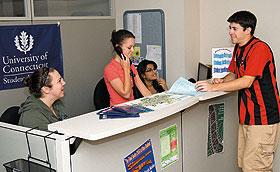  |
| HOME | THIS ISSUE | CALENDAR | GRANTS | BACK ISSUES | < BACK | NEXT > |
Activities office encourages students to become involved on campus by Sherry Fisher - September 15, 2008 | ||||
| “Are you shy? Are you a transfer or commuter student? A veteran? Interested in volunteerism, mentoring or club sports?” These are some of the questions posed to students in “The Ultimate Guide,” a magazine-like publication for students new to the Storrs campus. The piece was developed by the Department of Student Activities. “We wanted a piece that would cover more than just clubs and organizations,” says Christine Wilson, director of student activities, “something that would inspire students to become involved in campus activities. “We’ve found that for many students, it takes some bravery to join in and start taking part in campus life,” Wilson adds. “A small percentage of students will jump right in, but most students need more than that. They’re too shy to even ask another student to go someplace with them. They need a little push.” The booklet includes information boxes with headings such as, “Are you an artsy type?” “Are you in recovery?” “Are you an international student?” The accompanying text offers information about how to become involved. “Imagine trying to jump right into campus activities as a freshman and you’ve just gotten back from Iraq,” Wilson says. “We let those students know they can meet similar people in the Veterans’ Student Organization.” Lee Williams, dean of students says, “A quality student life experience on any campus is built on the back of a successful student activities program. But it has to be one that reaches into all corners of campus and brings students out of their rooms and their books and into the commons of the campus. There are many different paths to that commons, and this magazine provides multiple maps.” There are some 400 student organizations on campus, ranging from a cappella groups and sport clubs to economics and linguistics clubs. Wilson says many students who become involved on campus were apprehensive at first. “They say a friend or roommate dragged them someplace, or their CA talked them into going somewhere,” Wilson says. “We address their apprehension in the book.” One way that was handled was to profile six students who are involved in different campus activities, and talk specifically about how they got there. “We wanted new students to hear it from real people,” Wilson says. The guide also includes information on fraternity and sorority life, cultural centers, major events, fun places on campus, and religious organizations.
Anna Milot, publicity and marketing coordinator for student activities, designed the magazine. “Our main effort in creating it was to reach multiple types of students in a new way,” Milot says. “We wanted it to be all-inclusive and have an informal feel.” Addie Rodriguez was one of the students profiled in the guide. She says the guide is invaluable in helping freshmen learn “what is out there on campus. It’s orientation in a booklet.” Ryan Matthews, another of the students profiled, says he became involved with a tutoring program at the Mansfield Middle School after picking up a flyer at the Student Involvement Fair when he was a freshman. He is now the program’s director. Matthews also works for Recreational Services, as a Parent Orientation Leader, and as a teaching assistant in First Year Programs. In his profile, he advises students to “Talk to involved students. Go to all the events during Husky Wow. Or just walk through the Student Union one day. Exploring the UConn community is one of the best ways to go about getting involved.” Miguel Almodovar, also profiled in the booklet, says his love of stand-up comedy inspired him to join the SUBOG comedy committee. He wanted to have a say in which comedians came to campus. He got involved by simply showing up at the meetings. Wilson says the goal is for every single student to have a positive out-of-class experience. Student Activities now has ‘engagement ambassadors’ at its reception desk to help students and introduce them to opportunities for involvement. “They are being trained to be experts on all involvement opportunities on campus,” Wilson says. “They’re available for speaking engagements and for consultation – whether students want information on specific programs or just need to talk through available options, they can help. |
| ADVANCE HOME UCONN HOME |

